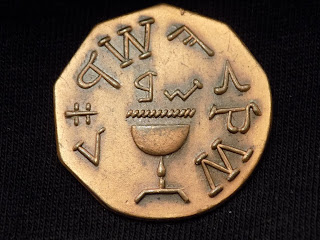The Chapter Penny and
Book of Marks
By Tom
Hendrickson-P.G.M.
The Mark Master degree is the first of the Royal Arch
Degrees. It is the completion of the Fellow Craft Degree, adding considerably
much more insight and detail about our ancient craft.
There are many valuable lessons in the Mark Master Degree,
but this paper will cover the areas surrounding the Chapter Penny and the Book
of Marks.
The Mark Master degree is believed to have been originated
by the ancient operative masons as a ceremony whereby the craftsman selected
his unique personal mark which was recorded in the Chapters Book of Marks. This unique mark would be the masonic
signature for the mason’s lifetime and the operative stone mason would place
his mark on the stones he prepared. The
mark would identify his work, served as a means of quality control and allowed
the mason to receive his wages for the work he performed.
During the building of King Solomon’s Temple there were two
classes of Fellow Crafts. The advanced masons were promoted based upon their
diligence and skill level to the Mark Master. The Mark Master was paid in coin
by the Senior Warden instead of being paid with corn, wine or oil. A week’s
wages were a Penny or a half-shekel.
It is tradition in the Royal Arch Chapters that they create
their own uniquely designed Chapter Penny. Each candidate who completes the
Mark Master Degree is presented with the Chapter Penny as a worthy token of the
rites of friendship and brotherly love. No, it’s not just another piece of
Masonic Bling.
The new Mark Mason then selects a distinctive mark that he
will keep for his lifetime and register’s the mark in his Chapter’s Book of
Marks. This mark is then inscribed on his Chapter Penny within the Keystone side
of the coin.
The remainder of this paper will examine many of the common
characteristics of various Chapter Pennies and half-shekels from Minnesota
Chapters.
I will also review some registered marks from various the “Book
of Marks” from Royal Arch Chapters and look at the designs from the simple to ornate
and beautiful works of art.
Now let’s take a look at some examples of Penny’s and Marks.
The most common Chapter Penny is having the obverse side-the
front of the coin (in Minnesota we call that heads) is divided into three
spaces by two circles. The inscription found in the outer most consisting of
the name, number and location of the Chapter. The middle space contains the
date when the charter was granted. The center space contains the word One Penny
using two lines.
The reverse side(tails) will have the keystone bearing the
letters H.T.W.S.S.T.K.S arranged in a circle. The center of the keystone is
reserved for the Mark of the owner.
The letters represent the Mark of our ancient Grand Master.
On the right a mallet, on the left a chisel.
This version of the Chapter Penny is fashioned to appear
like an ancient half Shekel. The Chapter information is contained on the
reverse side.
Each Royal Arch Chapter maintains a Book of Marks. This is
the master registry of all of the members Marks or their masonic signatures. As
our ancient brethren before us. It is very possible to leaf thru the pages and
gaze upon the marks of all of your Chapter members going back to the very
founders themselves. This is a great place to look at what your Father or
Grandfathers Mark may have looked like.
These books come in all shapes and colors. From the handmade
leather bound to a three-ring notebook.
When you examine the individual Marks you will see, some
were made by an artist directed by the member or some scratched out by the
member himself.
I have elected to show you a few ordinate Marks from the mid-1800s.
The form that each Mark Master is presented with to
complete.
The Chapter Penny and the Chapter Book of Marks are just a
few of the interesting and valuable lessons in the Mark Master Degree.
The lessons in the Royal Arch completes and fulfills the
degrees that we received in the Blue lodge. It is often said that the Master
Mason doesn’t fully grasp the whole story until he has completed his journey
through the Royal Arch.
If you are interested in learning more about your ancient
craft and wish to participate in its long traditions the Royal Arch is the only
place where you can do that.
I would like to say Many Thanks to the Minnesota Masonic Heritage Center and Doset Mark Anderson for helping me with this project
I would like to say Many Thanks to the Minnesota Masonic Heritage Center and Doset Mark Anderson for helping me with this project









No comments:
Post a Comment